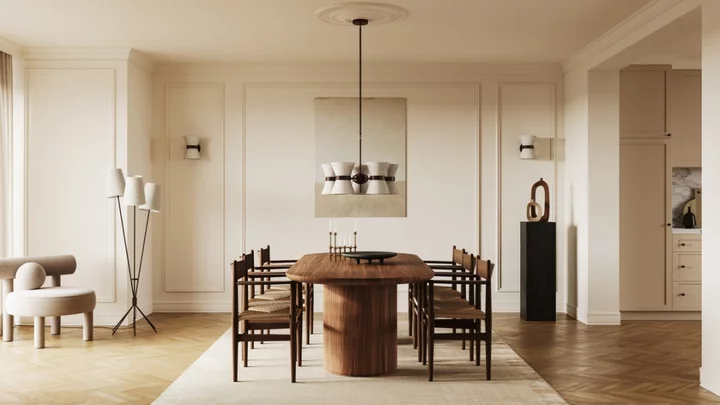
Andy Reid, Travis Kelce speak out on Chris Jones situation
As Kansas City Chiefs defensive tackle Chris Jones continues his holdout, head coach Andy Reid, and tight end Travis Kelce commented on the situation.
2023-09-04 06:20

Chiefs rumors: Chris Jones discussions not going anywhere
The Kansas City Chiefs and Detroit Lions are both on a rush week with the two teams set to face off in the season opener on Thursday Night Football. With that, Sunday becomes a Wednesday, an important day in the practice lifecycle for NFL teams.
2023-09-04 01:48

Disney wants to narrow the scope of its lawsuit against DeSantis to free speech claim
Disney wants to narrow the scope of its federal lawsuit against Gov. Ron DeSantis to just a free speech claim that the Florida governor retaliated against the company because of its public opposition to a state law banning classroom lessons on sexual orientation and gender identity in early grades
2023-09-04 01:20

Supercomputer predicts 2023/24 Champions League after group stage draw
The teams with the biggest chance of winning the 2023/24 UEFA Champions League using Opta's analytics.
2023-09-03 23:28

What is Merkel cell skin cancer? The signs and symptoms of the rare condition
Jimmy Buffett died aged 76 on Friday (1 September), in hospice care, after a years-long private struggle with skin cancer. In a statement shared on his website, it was announced that the singer, who was best known for his hit song “Margaritaville”, had been fighting Merkel cell skin cancer for four years. Cancer Research UK has recently warned that skin cancer cases are set to rise by half by 2040, with rocketing diagnoses driven by the “cheap package holiday” boom of the 1960s. Skin cancer is the most common form of cancer in Britain and kills around 2,100 people each year. It is also one of the most common cancers in the world. What is Merkel cell skin cancer? Merkel cell carcinoma (MCC) is a rare type of skin cancer. According to Cancer Research UK, it starts in the Merkel cells, which are usually in the top layer of the skin. These cells are near the nerve endings and they help us respond to touch. The charity states that MCC is a “very rare” form of skin cancer, with 1,500 people diagnosed with the condition in England between 1999 and 2008. What are the causes of Merkel cell carcinoma? With most types of skin cancer, long-term exposure to sunlight can increase a person’s risk of getting MCC. Other factors that could increase a person’s risk include being exposed to ultraviolet light, having a condition that can weaken your immune system or having a virus called Merkel cell polyomavirus (MCPyV). What are the symptoms? MCC usually appears as lumps on the skin. According to Cancer Research UK, the lumps are often a blue/red colour and less than 2cm across but sometimes they can be larger. The skin over them is usually firm and they are not painful. These lumps are often found on the areas of the body that get the most direct sun, such as the head, neck, arms or legs. Unlike most common types of skin cancer, MCC can develop rapidly over weeks or months and can spread to other parts of the body such as the lungs, lymph nodes, liver or bones. The NHS advises that if you are in doubt, contact your GP. How to prevent developing skin cancer Skin cancer is not always preventable, but you can reduce your chance of developing it by avoiding overexposure to UV light. You can protect yourself from sunburn by using high-factor sunscreen, covering up your skin while in the sun, and limiting the amount of time you spend in the sun during the hottest part of the day. Sunbeds and sunlamps should also be avoided. Read More Pregnant Kourtney Kardashian and Travis Barker seen leaving hospital after ‘urgent family matter’ Woman adopts husband’s ex-wife’s baby after growing up in foster care herself ‘People looked at me like I was oppressed in some way’: Young Christians on life in secular Britain How to check if you have skin cancer: Symptoms and signs to look out How many times a week you need to workout to get fit Post Malone shows off 55-pound weight loss in new photos after giving up soda
2023-09-03 22:50

Chiefs rumors: What a Chris Jones deal before Thursday could look like
The clock is ticking on a conclusion to the Chris Jones-Chiefs drama.
2023-09-03 22:48

Elaine's Unfortunate Dancing on 'Seinfeld' Was Inspired By a Television Legend
Could anyone dance that horribly in real life? Yes.
2023-09-03 22:28

How to check if you have skin cancer: Symptoms and signs to look out for
It is the most common form of cancer in Britain and kills around 2,100 people in the UK each year, but still, a “shocking” number of people remain unaware of the dangers of skin cancer, its links to sunburn, and how to spot the signs of this deadly disease. An overwhelming 77 per cent of people would not recognise signs of melanoma – a malignant skin cancer tumour – despite the majority of Britons worrying about skin cancer, a new study by the British Association of Dermatologists (BAD) has found. It comes as Cancer Research UK has warned that skin cancer cases are set to rise by half by 2040, with rocketing diagnoses driven by the “cheap package holiday” boom of the 1960s. Skin cancer diagnoses hit record levels of 17,545 a year between 2017-19 and based on the charity’s predictions, that figure is set to rise to 26,531 each year by 2040. There are two types of skin cancer; melanoma, the deadliest form of which around 13,000 new cases are diagnosed each year in the UK, and non-melanoma, of which there are more than 100,000 new cases diagnosed every year. The risk of melanoma is doubled if a person has had five or more sunburns at any age, the Skin Care Foundation states, but adds that experiencing just one blistering sunburn in childhood or adolescence more than doubles a person’s chances of developing a melanoma later in life. Non-melanoma comes in two most common forms: basal cell carcinoma, which accounts for about 75 per cent of skin cancers, and squamous cell carcinoma, which accounts for about 20 per cent. It is mainly caused by overexposure to UV light. But despite the serious risks of cancer posed from sunburn, nearly three-quarters of people surveyed by BAD admitted to having been burned in the past year alone, while 40 per cent of people were found to never check themselves for signs of cancer. Here is how to check for possible signs of melanoma and non-melanoma skin cancer: Melanoma: The NHS states the first signs of a melanoma is often a new mole, or a change in the appearance of an existing mole. Moles are usually round or oval, with a smooth edge, which is not bigger than 6mm in diameter. Any change in size, shape, or colour, any bleeding, crustiness or itchiness, or how painful a mole is should be shown to a doctor. The NHS has an ABCDE checklist to help people tell the difference between a normal mole and a melanoma: Asymmetrical – melanomas have two very different halves and are an irregular shape. Border – melanomas have a notched or ragged border. Colours – melanomas will be a mix of two or more colours. Diameter – melanomas are larger than 6mm (1/4 inch) in diameter. Enlargement or elevation – a mole that changes size over time is more likely to be a melanoma. Non-melanoma: Non-melanoma usually appears as a lump or discoloured patch of skin that does not heal. If a person experiences on of these patches that do not heal after four weeks, they should see their GP. Signs of Basal cell carcinoma can look like a small red or pink lump, though it can also appear as a pearly-white or waxy-looking lump, or it can also appear as a red or scaly patch of skin. The lump, whether pink or white, will grow slowly and can become crusty or bleed, or become a painless ulcer. Signs of Squamous cell carcinoma are the appearance of a firm pink lump. This lump could have a flat, scaly or crusted surface, often bleeds easily and feels tender to touch and can also become a painless ulcer. Read More UK skin cancer statistics 'shocking' Skin cancer referrals up 41 per cent in 5 years Wolverine star Hugh Jackman treated for skin cancer Cheap holidays blamed for huge rise in skin cancers How to check if you have skin cancer: Symptoms and signs to look out Chris Evans reveals he’s been diagnosed with skin cancer How many times a week you need to workout to get fit
2023-09-03 21:51

How Man City could line up with Matheus Nunes
With Matheus Nunes moving to Manchester City from Wolverhampton Wanderers in a £53m deal, 90min looks at how Pep Guardiola could line up with the Portuguese midfielder.
2023-09-03 21:26

Students transform their drab dorm rooms into comfy living spaces
A studded headboard for your dorm bed
2023-09-03 21:25

Joe Rogan's heartfelt moment: 'JRE' host opens up about getting emotional for Rose Namajunas at UFC 261
Joe Rogan shared his experience of interviewing UFC Women's Strawweight star Rose Namajunas after her UFC 261 fight with Weili Zhang
2023-09-03 20:53

Your most asked interior design questions – answered by experts
Designing a home that feels “just right” is no small feat. It’s about achieving that delicate balance of form and function, curating an environment that shows off your personal style but is also timeless and versatile. With this endeavour in mind, I’ve scoured Google and compiled a list of the most common design and decoration queries. I then asked nine of the UK’s leading interiors experts to give their sage wisdom. Read on to see if your burning questions are finally answered. How do I discover my own design style? Your personal style is the combination of design elements that reflect your tastes, preferences, personality, and overall aesthetic. Many of us need a bit of a hand when it comes to figuring out exactly what this looks and feels like. Luxury London-based interior designer Naomi Astley Clarke explains: “From Instagram to TikTok, there’s no shortage of design inspiration at our fingertips, and as a result, we’re increasingly influenced by widely varying aesthetics. This can lead to confusion about what we really want our own living spaces to look like. To discover your own style, think first about your lifestyle and how you envision your home functioning to support and enhance that. Rather than fixating on achieving a beautiful aesthetic, ask yourself – how do I need this space to make me feel? For example, in your bedroom, you’ll want to be relaxed and well rested. Consider the colours, materials, and things that will help you achieve that feeling.” She continues, “If you are someone who has collected a lot of inspiration photos, search for common themes that standout. From there, your interior designer will be able to help you to develop those beloved motifs, colours, and styles into a cohesive, liveable space that’s entirely bespoke to you.” What kitchen mistakes should I make sure to avoid? Don’t force an island into a space that’s simply not big enough. Tom Howley, design director of the eponymous bespoke kitchen company, explains: “Kitchens need to be as functional as they are beautiful, and sacrificing floor space to fit an island will just give an awkward, uncomfortable look. The importance of walkway space should be a key consideration. When designing your layout, always leave a metre of walkway space on either one or two sides of your worktop, island, or peninsula counter.” Additionally, don’t skimp when it comes to your cabinetry – environmental and quality issues often lie behind exceptionally cheap prices. Howley adds, “Invest in high-quality cabinetry as it will last a lifetime and can be easily repaired and repainted, thus extending the life of the entire kitchen and ultimately saving you money in the long run. Solid wood always looks and holds up the best.” Which kitchen worktop material is best? Kitchens are a busy place and the work surfaces, more than any other part, really takes the brunt of this. Astley Clarke explains, “Kitchen worktops are used constantly – from unloading groceries and chopping vegetables to serving as offices and homework hubs. They’re the foundation of all activity that goes on in the heart of a busy home. Marble is one of the most elegant and luxurious worktop options, but the drawbacks, along with the high cost, are that it is a soft, porous stone, making it prone to staining and chipping, especially in high-traffic kitchens. If you want the look of marble but with more practicality, I recommend quartz as it offers a natural stone aesthetic whilst being extremely durable, virtually non-porous, and stain and scratch resistant.” Jonathan Stanley from Caesarstone, the engineered stone worktops pioneer, adds: “It’s important to prioritise low-maintenance and longevity when choosing a worktop for your kitchen. Natural stone, such as marble, is highly susceptible to staining, especially in a busy hub such as the kitchen. To avoid substantial damage, you would have to seal your marble countertops at least annually. Caesarstone, on the other hand, requires virtually no maintenance. A simple soap and water solution is enough to gently cleanse our surfaces, with no need to wax or seal them. We also offer a lifetime warranty across all our indoor surfaces, ensuring durability and cementing your worktop as a worthwhile one-off investment.” How do I make my small flat feel larger? Making a small space feel bigger is all about tricking the eye. Athina Bluff, founder and lead designer for interior design studio, Topology, advises, “Try to show as much floor space as possible. Think about how you can swap out something chunky for something wall mounted and lightweight, such as a desk on four legs for a floating one. Additionally, opt for glass and Lucite furniture. The more you can see around and through the item, the more light will travel through the room, allowing further floor space to be visible.” Sophie Clemson, director and co-founder of online interior design service, The Living House, adds: “Think big and opt for a large rug to help anchor your living room. Make sure this rug is large enough to fit under your entire sofa – if it’s too small, it will look like it’s floating in the middle, making the room feel disjointed and more cramped.” Clemson continues, “Paint your ceiling the same colour as your walls – this helps blur the edges and make the room feel more spacious. Avoid a feature wall as this can make the wall feel like it’s coming towards you, causing the space to feel especially narrow. And if you have an open plan flat, use the same flooring throughout to create a cohesive flow that makes the space feel vaster.” What is layering lighting, and why is it important? Layered lighting is the combination of multiple, varying sources of light which, when put together, cast a pleasing glow around a room. For example, these could include an ornate, Rococo-style, gilt chandelier hanging from the ceiling, combined with a couple of sconces with endearingly petite, hand-woven lampshades on either side of a mirror, and a floor lamp with a curved brass stem, which softly illuminates a dim corner. “A layered approach allows you to adapt the lighting in your home to suit your evolving moods and needs,” explains Niki Wright, co-founder of lights&lamps, an ever-evolving curation of contemporary design-led lighting. “Think of your lighting like the sun. Big and bright in the day, then gradually becoming lower and softer by night. When ceiling lights are no longer needed to see by, you can switch to more subtle table and floor lamps. Imitating the setting sun organically transitions your living space throughout the day, bringing peace and calm before bed.” How do I choose and style artwork to match my living space? Award-winning British interior designer, Matthew Williamson, tells me: “When sourcing art for your own home, it’s important to bear in mind that the only person it needs to impress, touch, or inspire is you. Never buy art to impress or pander to anyone else, any trends, or because you think something would ‘look the part’ in a room. Above all, your collection needs to resonate with you, whether it reminds you of something fundamental about the way you wish to live your life, or it simply makes you smile.” Martin Waller, founder of global design brand Andrew Martin adds, “Hang your artwork at eye level or just above, creating shapes and patterns with multiple pieces to form a cohesive gallery wall. For example, if you have two portraits, face them towards each other as if they’re having a conversation and make themes like putting all your pictures of animals together, even if they’re of different styles and eras. The important thing is to tell a story with your curation. You can also play with colour by organising a group of monochrome pieces with one vividly coloured work in the middle.” Waller continues, “Don’t be afraid to put very contemporary art in a traditional space, or vice versa – it is often the merging of seemingly incongruous styles that creates beauty through surprise. And when considering your colour scheme, pinpoint one or two of the boldest colours in the room and reflect them in your chosen artwork. Or, working inversely, pick out a hue you love in your artwork and highlight it by using the same tone in cushions and other soft furnishings. This works similarly with shapes – you can mirror a circular shape in an image with a spherical vase or sculptural lamp for example.” What are some inexpensive ways I can make my space feel more luxurious? Anne Haimes, design director and founder of Anne Haimes Interiors says, “To make your home look more high-end I always recommend framing your artwork. Inexpensive prints are a great way to introduce personality into your home without breaking the bank on costly art. But time and time again I see people neglect to frame their prints, which unfortunately creates the look of posters in a teenager’s bedroom. Second-hand shops often have beautiful but cheap vintage frames that will help uplift your existing art.” She continues, “Another trick is to swap out any branded soap bottles or washing-up liquids you may have in your kitchen and bathrooms for glass or ceramic vessels. Replacing branded plastic packaging with a dispenser of your choice will make your home appear much more cohesive. You may also be able to save some money in the long run by buying more cost-effective and sustainable refill packs.” Athina Bluff adds, “For a small but impactful detail that will make your space feel more premium, change your switches and sockets from white to brass or a sleek black. And opt for feather down cushion inserts, removing all foam cushion pads. Foam cushions often sag and don’t age well, whereas feather-filled ones feel very reminiscent of a boutique hotel. Make sure to give them a classic ‘karate’ chop for ultimate luxury.” Astley Clarke finishes, “A premium scented candle in an elegant votive instantly elevates a space. The aroma-filled flicker of a candle can be both meditative and escapist, making your space extra inviting and boosting your spirit. Hotel Costes’ ‘Brown’ candle is my favourite. Crafted with an exquisite attention to detail and quality that makes it well worth the price tag, the iconic Parisian hotel’s signature scent was inspired by an ironwood piece of furniture from the Ming dynasty that emits scents of liquor, mild tobacco, and wet stone.” Read More Kourtney Kardashian and Travis Barker leave hospital after ‘urgent family matter’ Harry and Meghan spotted at Beyonce’s Renaissance tour in Los Angeles ‘People looked at me like I was weird’: Young Christians on life in secular Britain How to soften city living with laidback English country design Interior designer Naomi Astley Clarke on how to add value to your home ‘I think a better word for “clean” beauty is “thoughtful” beauty’ Mediterranean muses, wild blooms and shrooms: Trends to watch from this year’s Chelsea Flower Show
2023-09-03 18:52
